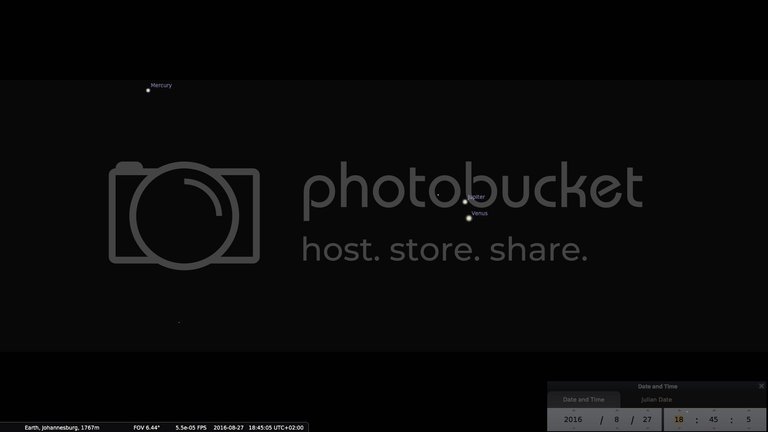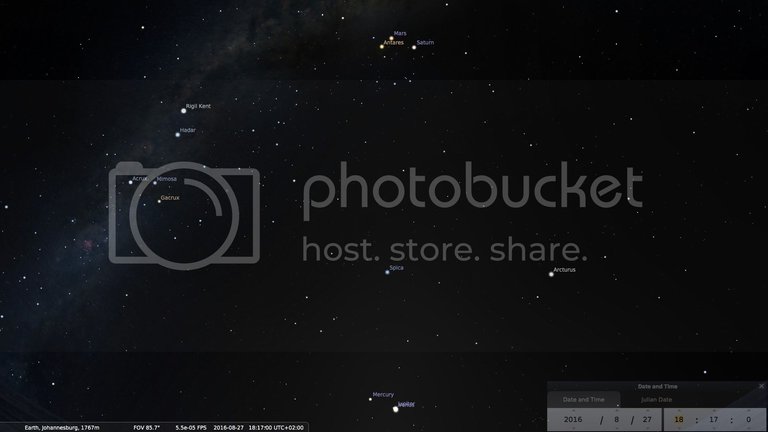An introduction to Jupiter and Venus through a recent conjunction
This past weekend’s close encounter between the planets Jupiter and Venus was a rare event. For those who were watching the western sky, just after dusk, the two planets came so close to each other as to appear to nearly touch, although still clearly visible as separate “stars” with the naked eye.

In astronomical terms, such a near conjunction is known as an “appulse”; and at their closest, the planets were within 4 arc minutes from each other.
An arc minute is a measure of distance in the sky, where 60 arc minute equals 1 degree. For the layperson, holding your fist at the full extension of your arm, while closing one eye, will block out about 10 degrees of sky. The earth’s rotation causes a relatively fixed object in the night sky (like a star) to move 360 degrees in 24 hours, or a quarter of a degree (or fifteen arc minutes) per minute.
On Saturday 27 August 2016, observers in the Western Hemisphere saw the planets at between 6 and 10 arc minutes apart; European and African viewers (like myself, from Johannesburg, South Africa) were treated to approximately 12-13 arc minutes; while Japan, East Asian and Australian viewers’ sight was still spectacular at 30 arc minutes or half a degree. If you had held a pencil at arms length, the back of the pencil would have blocked out the event. If you had been watching the stars against a fixed, clear horizon, it would have taken between 15 seconds and 2 minutes, depending upon where in the world you were watching, for the distance between the planets to have passed.
Proximity between Jupiter and Venus happens approximately every three to six years
(the difference is accounted for because not all proximities are visible), but not all encounters are the same: this last event will not repeat itself until 2065. This means that many of the readers of this article will likely not be alive to witness it again. Venus was also beautifully bright (because Venus is an inferior planet – closer to the sun than the earth – it waxes and wanes, like the moon) at above 90% illumination, making its conjunction with blue Jupiter all the more brilliant.
This appulse was still further unique by virtue of the fact that all five planets were visible during the same night :
to the left of the waltzing Jupiter and Venus, Mercury looked on wistfully; Mars and Saturn glowered ominously in a triangle with the constellation Scorpio’s red Antares from near zenith overhead.

Having all five planets visible during the same night only occurs for short periods of time - and we are in such a period at the moment. It requires that Jupiter and Saturn be within 180 degrees of each other, which excludes approximately 10 of the 20 years it takes for a grand conjunction between these august peers. Mars takes 686 days for its revolution, which roughly excludes alternate years of the possible 10. Venus is visible for two periods of its 224 day orbit: as the morning star for about 8 weeks, and as the evening star for a similar period about two months later. Finally, fleet-footed Mercury is only visible for two three-week periods (assuming there is nothing obstructing a viewing close to the horizon) every 88 days, which misses Venus’ appearance more than half of the time. Thus in a twenty year cycle there are only a handful of three week periods during an aggregate of five candidate years when all of the planets are visible during the same night.
The curiosity of this event calls into mind a similar but yet more spectacular appulse that occurred on 17 June 2BCE.
That conjunction has been proposed as being connected with the Star of Bethlehem – a controversial astronomic event recorded by Matthew in the New Testament. To some who believe in the account, the story is a remarkable illustration of how acting in faith can move persons to witness eternally significant events. To the skeptic, the event is no more than pious fable – perhaps even a fraud. Wherever one sits in relation to this debate, it has received attention from some of the greatest minds, including Johannes Kepler (1571-1630) and Sir Isaac Newton (1642-1727).
The appulse of 17 June 2BCE, viewed from the middle east at between 20:30 and 21:30, presented Jupiter and Venus within 36 arc seconds of each other. That is much closer than our conjunction, or within 0,01 degrees. It is a conjunction the degree of which has not been repeated in millennia.
The ready availability of planetarium software permits anyone with access to a computer to rewind the clock and view these events, as if there, on the night in question. In following posts, an evaluation of the truth claims of the gospel account will be undertaken. What will be presented may lay the basis for an argument that an extremely unique astronomic sequence of religiously laden events unfolded that could explain each of the essential features of the Star of Bethlehem story. It will provide a basis for evaluating between several competing claims that have been advanced in explanation of the phenomenon.
So, follow along; and if you can, download an available planetarium software (I use Stellarium a free download easily found through Google) and enjoy the ride! (the images are created using it)
The astronomy and his mysteries .. it is curious as something that we have at sight every day can manage to surprise us.
A clear night and a sky full of stars can hypnotize anyone
Agreed!
There seem to me to be at least three approaches to astronomy. The first is mesmerised awe at the wonder of it all, with little effort or interest in discerning any order, system or meaning hidden within the gorgeous jewellery box above us.
The second is to try to peer deeper and deeper into space with more advanced instrumentation. Most of us quickly hit a resource ceiling. I rely on others to share their finds with me, and like an App, Astronomy Picture of the Day (APOD) that feeds me with delightful pictures and interesting facts.
And thirdly is to follow the constellations and planetary conjunctions and attempt to find meaning and system in the events (although I am not overly interested in the modern face of astrology). In addition to using Stellarium as my planetarium software, I also use an app on my phone called SkyView. This app allows you to point its back to the sky and identifies the objects and constellations you're viewing. It also has a search capability. This has allowed me to recognise what I am looking at. Highly recommended - but of course, each to their own. Hope you will find further interest in additional posts.
Nice info, champ. Thanks alot.
Thanks! Hope you will like the parts to follow!
I was enjoying 2 months ago watching Mars from Sweden . I think that was a some sort of lineup of Mars , to the left and up a bit Neptune . It was great .
Neptune, with its slow orbit is in Aquarius at the moment - although it needs a telescope to be spotted.
Mars has been very interesting: it moved westward, past Saturn, stopped and moved eastward, stopped, moved westward again, and is presently passing Saturn again. This is due to a phenomenon called retrograde motion that is simply an optical illusion that occurs as the earth, in its relatively shorter orbit, catches up to Mars which, relative to its background of stars (including slow-moving Saturn), causes it to appear as if Mars stops, moves backward and then moves forward again.
Its a great show which we in the Southern Hemisphere can enjoy, where Scorpio still dominates our winter night sky. In northern latitudes, such as Stockholm, at the moment, because Scorpio is low on the Southern horizon, and darkness arrives so late, it will be difficult to see this interaction at all, even without discounting for the light pollution.
Thanks for your comment and hope you enjoy the future posts.
Man i wish to know more , i got hooked up really bad that night . I was always interested in this theme but i never been able to put some time and effort to learn at least basics . Now i do so now i always read something about it . Following and voting . Keep up .
Mars has been doing an interesting dance in scorpio for a while now... with Saturn and Antares. Neptune not visible to the naked eye... were you using binoculars or a telescope?
My friend has a telescope but we don't have experience with that . We where exited like kids , learning new tings . Eventually we found Neptune hehe.
How does one go about getting featured by you? Thanks
I'm in steemit chat... but it on a go-slow at the moment
Do we need to contact you there in order to be featured or do you find articles yourself?
Great article and well researched. It is a bit complicated to me, but it is great that a person can go back so many years and prove what was writen in the bible is something that really happened.Hi @vuyusile
Thanks for your comment. I must offer caution about concluding that we can prove the Biblical account. That is because at best it is a second hand account written to promote faith rather than offer a scientific record. The Magi did not tell us, save in general terms and not with language that we would find definitive, what they were looking at and what motivated them to undertake their journey, save, as I said, for their apparent faith.
There are several aspects of the account which have presented difficulties for a critical reader. These include historical dating of the birth event and scientific incredulity at the claim that a star could have guided the travelling Magi. My articles will at best provide rational plausibility; an argument that says that given what was there to be seen, we can advance plausible reason for their behaviour; and that we should be slow to dismiss a story about men from an elite class (astronomers) that left a privileged background in a cosmopolitan centre to come looking for an infant in the relative backwoods of Jerusalem. And to arrive there and declare with confidence that they were seeking a child of royal birth; and once they had found him, to pay homage to him.
These are all extraordinary claims, given the historical context. I hope that my findings might examine that context and find reason to be more reflective when considering the truth claims of the account.
I went up the coast to get away from bright lights and too took some photo's ... but all in all it was a bit of damp squib for me {grin}
Sorry to hear it ... I stepped out of my perimeter gate and onto my east/west aligned road which had cleared a path to the horizon where I had a great view, but didn't take any pictures. Was only introduced to steemit the next day when I had the idea to start writing this all up, and was sorry not to have taken pictures then. Maybe you can share yours if they came out successfully.
I shall see if I can find a decent pic, will post here o your thread if okay by you??
No problem!